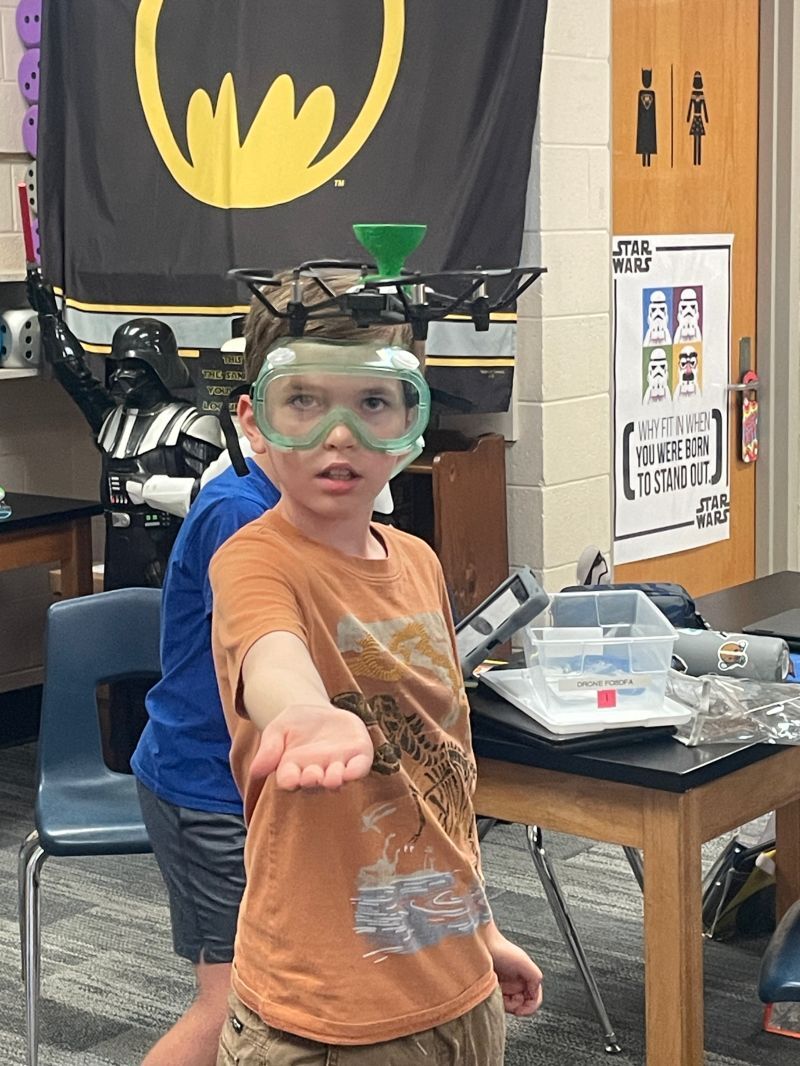Welcome to “Learning to Code with Drones: An Interactive Approach for Grades 4-8,” where the future of STEM education takes flight!
In this blog post, we delve into the world of drone coding, an innovative way to introduce young minds to STEM (Science, Technology, Engineering, and Mathematics) through the engaging and hands-on experience of drones.
We’ll look at how drone clubs are becoming a vibrant part of school communities, providing students with a platform to collaborate, create, and compete. These clubs are not just about flying drones; they’re about coding them, understanding their mechanics, and exploring the endless possibilities they offer in learning and creativity.
Join us as we navigate through the exhilarating world of STEM with drones, where every flight is a new learning opportunity and every coding challenge a step towards the future of education.
Whether you are a teacher looking to enrich your STEM curriculum, a parent seeking innovative learning tools, or a student eager to embark on a thrilling educational journey, this blog is your runway to the skies of knowledge and creativity!
Why STEM Matters
- Interdisciplinary Learning: STEM bridges the gap between science, technology, engineering, and mathematics. This approach mirrors real-world scenarios where multiple disciplines interact, providing students with a holistic education.
- Critical Thinking: By tackling challenges that require both logical and creative solutions, STEM education sharpens students’ analytical and innovative problem-solving skills, preparing them for complex future tasks.
- Future-Ready Skills: As the job market evolves with technology, STEM education equips students with adaptable skills, making them versatile candidates for a range of careers in the future.
- Creativity and Innovation: The inclusion of art in STEM encourages students to think outside the box, fostering creativity that can lead to innovative discoveries and solutions in technology and science.
- Real-World Applications: STEM focuses on practical applications of academic concepts. This hands-on approach helps students understand how their learning applies in real-life scenarios, enhancing their engagement and retention.
Advantages of Drone Coding in the Classroom
- Practical Learning Tool: Drones provide a tangible way to see coding in action. When students program drones and see them respond, it reinforces their understanding of coding principles in a real-world context.
- Enhances STEM Integration: Using drones in coding lessons seamlessly ties together various aspects of STEM. For example, programming a drone flight path combines coding (technology) with understanding aerodynamics (science) and geometric patterns (mathematics).
- Visual Feedback: The immediate response from a drone’s flight provides instant feedback to students, helping them quickly grasp the effects of their coding decisions and understand the cause-and-effect relationship in programming.
- Comprehensive Understanding: Drone coding goes beyond software; it also involves understanding hardware. Students learn not only how to write code but also about the mechanics and electronics of drones, providing a well-rounded technological education.
- Engagement and Excitement: Drones bring an element of excitement to the classroom, making the learning process enjoyable. This excitement can increase engagement and interest in STEM subjects, particularly among students who might not be reached through traditional teaching methods.
Implementing Drone Coding in the Classroom
Introducing drone coding into the classroom is an exciting way to enhance STEM education. This section provides practical advice for teachers on how to integrate this innovative approach effectively.
- Understanding the Technology: Before introducing drones to students, it’s important for teachers to familiarize themselves with the drones and coding software. Consider attending a workshop or online course if necessary.
- Choosing the Right Equipment: Select drones that are suitable for educational purposes – durable, safe, and with programming capabilities that align with your curriculum goals.
- Designating a Safe Flying Zone: Ensure there is a safe and open space for drone activities, free from obstacles and hazards.
- Establishing Safety Protocols: Educate students on safety measures, including handling drones and staying clear of the flying area during operations.
- Guiding Inquiry and Exploration: Rather than direct instruction, focus on guiding students’ exploration and inquiry. Encourage them to ask questions, hypothesize, and experiment with coding solutions.
- Encouraging Collaborative Learning: Foster an environment where students work together on drone projects, sharing ideas and learning from each other.
- Technical Difficulties: Prepare for technical issues with drones or software. Having a troubleshooting plan and backup activities can ensure the continuation of learning.
Professional Development for Teachers
As drone coding becomes an integral part of the STEM curriculum, it is essential for educators to stay abreast of this evolving field. Professional development is key to ensuring teachers are well-equipped to bring this innovative technology into the classroom effectively.
- Staying Updated: The field of technology and drone applications is rapidly evolving. Continuous learning helps teachers stay current with the latest trends, tools, and teaching methodologies.
- Building Confidence: Proficiency in drone technology and coding increases teachers’ confidence, enabling them to facilitate more effective and engaging learning experiences.
- Workshops and Training Sessions: Look for workshops specifically designed for educators that focus on drone coding and its application in STEM education.
- Online Courses and Webinars: There are numerous online platforms offering courses on drone technology, coding, and educational strategies for integrating these into the classroom.
- Educational Technology Conferences: Attend conferences and seminars that focus on the latest in educational technology. These events are also great for networking with peers and sharing best practices.
- Guest Lectures and Demonstrations: Invite industry professionals to your classroom for guest lectures or demonstrations, providing students and teachers alike with firsthand insight into real-world applications of drone technology.
- Online Forums and Social Media Groups: Engage with online communities focused on drone technology in education. These platforms can offer a wealth of information and a space to ask questions and share experiences.
- Conducting Workshops or Webinars: As you gain expertise, consider conducting your own workshops or webinars to guide other educators. Teaching others is a powerful way to consolidate your own learning.
Coding in Classrooms: A Gateway to Future Job Opportunities
In the rapidly advancing world of technology, coding is no longer just a skill—it’s a fundamental literacy. Introducing coding in classrooms, particularly through engaging methods like drone coding, can open a myriad of job opportunities for students. Here’s how drone coding within STEM education prepares students for the future workforce.
- Technology Proficiency: In an era where technology underpins most industries, proficiency in coding sets students apart. Drone coding, in particular, provides hands-on experience in a cutting-edge field.
- Problem-Solving Skills: Coding teaches logical thinking and problem-solving, skills that are highly valued in any career. Tackling challenges with drones requires creativity and innovation, further enhancing these abilities.
- Diverse Tech Careers: Knowledge of coding and drone operation opens doors to various career paths in technology sectors, including software development, robotics, data science, and AI.
- Emerging Drone Industries: As drone technology evolves, new industries emerge, ranging from aerial photography to drone-assisted logistics and agriculture, offering unique career opportunities.
- Building a Professional Network: Participation in drone clubs can help students build connections and gain exposure to industry professionals, aiding their entry into the workforce.
- Adaptability and Continuous Learning: The process of learning drone coding teaches adaptability and the importance of continual learning, traits essential for navigating the ever-changing job market.
By integrating coding, particularly through engaging and innovative methods like drone coding, into classroom learning, educators are not only teaching a valuable skill but are also setting the stage for students to explore a wide range of career opportunities.
We invite you to join us in this exciting venture. Whether you are implementing drone coding in your classroom, participating in a drone club, or simply exploring the world of STEM, remember that each flight, each line of code, and each challenge overcome is a step towards a brighter, more innovative future.
At Drone Legends, we help kids in grades 5–8 learn about STEM by giving them an educational drone curriculum. We have taught hundreds of teachers from all over the world how to use our program to make learning fun.
Want to learn more about our STEM drone curriculum? Join the Drone Legends community of industry experts and drone enthusiasts today.




